Effects of microcystins on the growth and the activity of superoxide dismutase and peroxidase of rape (Brassica napus L.) and rice (Oryza sativa L.).
Ключови думи
Резюме
Microcystins are naturally occurring hepatotoxic cyclic heptapeptides produced by some toxic freshwater cyanobacterial species. In this study, crude extract of toxic cyanobacterial blooms from Dianchi Lake in southwestern China was used to determine the effects of microcystins on rape (Brassica napus L.) and rice (Oryza sativa L.). Experiments were carried out on a range of doses of the extract (equivalent to 0, 0.024, 0.12, 0.6 and 3 microg MC-LR/ml). Investigations showed that exposure to microcystins inhibited the growth and development of both rice and rape seedlings, however, microcystins had more powerful inhibition effect on rape than rice in germination percentage of seeds and seedling height. Microcystins significantly inhibited the elongation of primary roots of rape and rice seedlings. Determination of the activities of peroxidase and superoxide dismutase demonstrated that microcystin stress was manifested as an oxidative stress. Using ELISA, microcystins were examined from the extract of exposed rape and rice seedlings, indicating that consumption of edible plants exposed to microcystins via irrigation route may have health risks. Significantly different levels of recovered microcystins between exposed rice and rape seedlings suggested that there might be different tolerant mechanisms toward microcystins.



